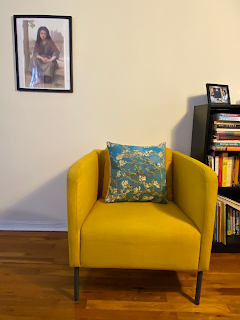In last week's Torah portion, Vayakhel, Moses instructs the Israelites to keep the Sabbath and then gives them detailed instructions for building the mishkan, the portable house of worship that will allow G-d to live among the people as they wander the desert.
These instructions sound very familiar, as they’ve already appeared in an earlier Torah portion, Terumah. In that portion, G-d is telling Moses, who is with G-d on Mount Sinai, what to tell the Israelites about how to build the mishkan. Meanwhile, at the base of the mountain, the people get tired of waiting for Moses and make a golden calf to worship. In this week’s portion, after getting angry at the Israelites, smashing the tablets, and going back up the mountain for new tablets, Moses finally gets to convey G-d’s message to the Israelites, and they build the mishkan just as G-d had specified.
The mishkan instructions do not call up an image of a magnificent structure any more than the steps of an Ikea instruction manual, to borrow a reference that Rabbi Matt Green made in a drash about parashat Terumah, would suffice to show you what your chest of drawers should look like. With a chest of drawers, though, you already know what it’s supposed to look like. Not so for the mishkan—at least, not so for me.
I wonder what the purpose of including so many details, and including them twice, was for the writers of the Torah. Were they trying to preserve instructions for building the mishkan in case the Jews ever needed to build it again? Did it not occur to the authors to say “Moses told the Israelites what G-d had told him,” rather than repeating it all? I don’t know and would like to learn know how others have answered this question.
The part that I like best about this parsha is the description of the lampstand—menorah, in Hebrew. Finally, something I can recognize because of the familiar word and also because of the description of a structure with three branches on each side. If the mishkan description gave us the menorah (and this is the first mention of menorah in the Torah, according to My Jewish Learning), maybe it was worth slogging through the less reader-friendly sections. Then again, perhaps other parts of the mishkan resonate with other people or will resonate with me another year.
The text says that the cups of the menorah were shaped like almond flowers, per G’d’s instructions. That’s quite the detail. Interesting that the menorah would have branches and flowers, like a tree. (Makes me think of the burning bush, but that's another subject for another day.)
I Googled “almond flowers” and happened upon something else familiar. What came up first, before photographs or direct references to nature or botany, was an image that is stitched onto a pillow that I see with a turn of my head as I sit here writing of branches and white blossoms against a blue background. It’s Van Gogh’s Almond Blossom, and it can be found patterning all sorts of objects in addition to pillows. The painting itself lives in Amsterdam’s Van Gogh Museum.
I doubt that Van Gogh had Judaism in mind when painting that work, but my Almond Blossom pillow does relate to my life as a Jew. After I had converted to Judaism, friends of our family sent me the pillow as a gift to celebrate my conversion and to thank me for some baked goods I’d sent them as care packages. They’d heard about the tradition of reclining on pillows during the Passover seder and so sent me a very fine pillow to recline on during my first Passover as a Jew.
I had been sending baked goods because the husband in the couple was dying. He died on what was the eighth day of Passover that year. (These friends aren’t Jewish, by the way.) Now the pillow, which sits in a yellow chair in my apartment looking beautiful and occasionally cushioning someone’s back, is a memory of him and of his surviving wife.
This past Shabbat at CBE, Rabbi Green spoke about our wish to see ourselves mirrored in the world, referencing the women’s mirrors that were built into the mishkan. I wanted to find myself mirrored in the Torah portion and so was thrilled to discover in it not just a menorah but one patterned with blossoms that, it turned out, were sitting right next to me on the Van Gogh pillow.
Yet the pillow and its blossoms weren’t entirely known to me. I didn’t remember that it depicted almond blossoms. I knew it was Van Gogh, but I just thought of it as showing a flowering tree. I didn’t remember that it was an almond tree or know that almond trees are the first ones to bloom in Israel in the spring. In addition to finding something familiar, I learned something about the pillow, about the world, from studying the parsha. It was more than a mirror. Perhaps next year, I’ll find a connection to, say, dolphin skins.
In a way, just by being Jewish, or maybe even just by being interested (I say to include my former non-Jewish self), we are connected to every parsha. The pillow was there sitting on the chair, and I had a connection to it whether or not I knew that the blossoms on it were from an almond tree. Learning more about the Van Gogh painting just deepened the connection or traced a path for it. The Torah is there “on the chair,” so to speak, for every Jew. Maybe every parsha reflects us, in some way, whether or not we know it. The connections are there for the finding. And chances are, as we seek out familiarity, something we knew, we’ll also find something new.
If this were Shabbat, I would say Shabbat Shalom. As it is, I wish everyone a shavua tov.


No comments:
Post a Comment